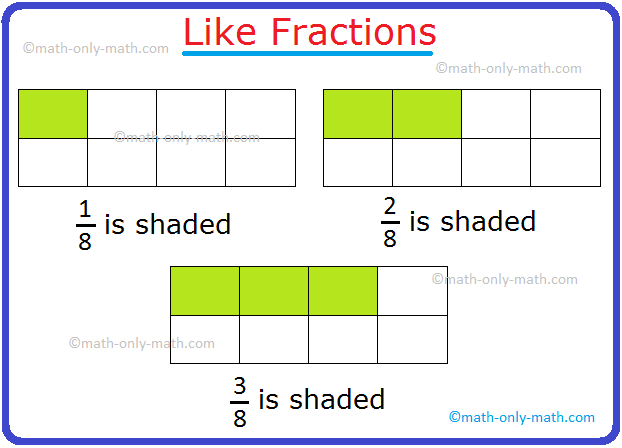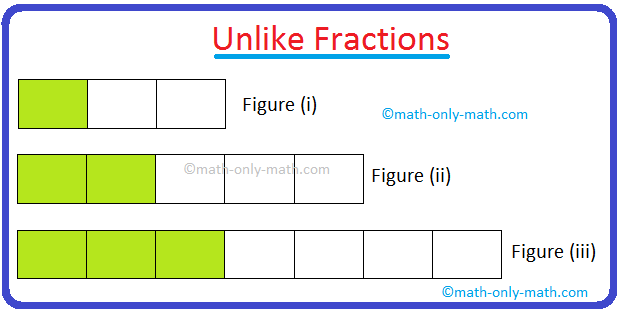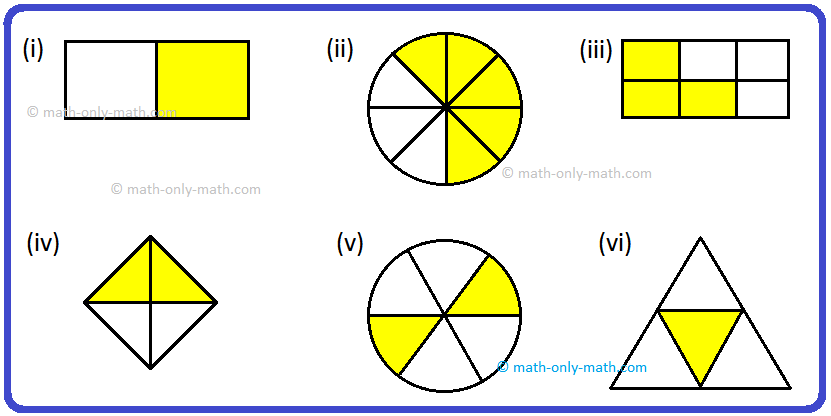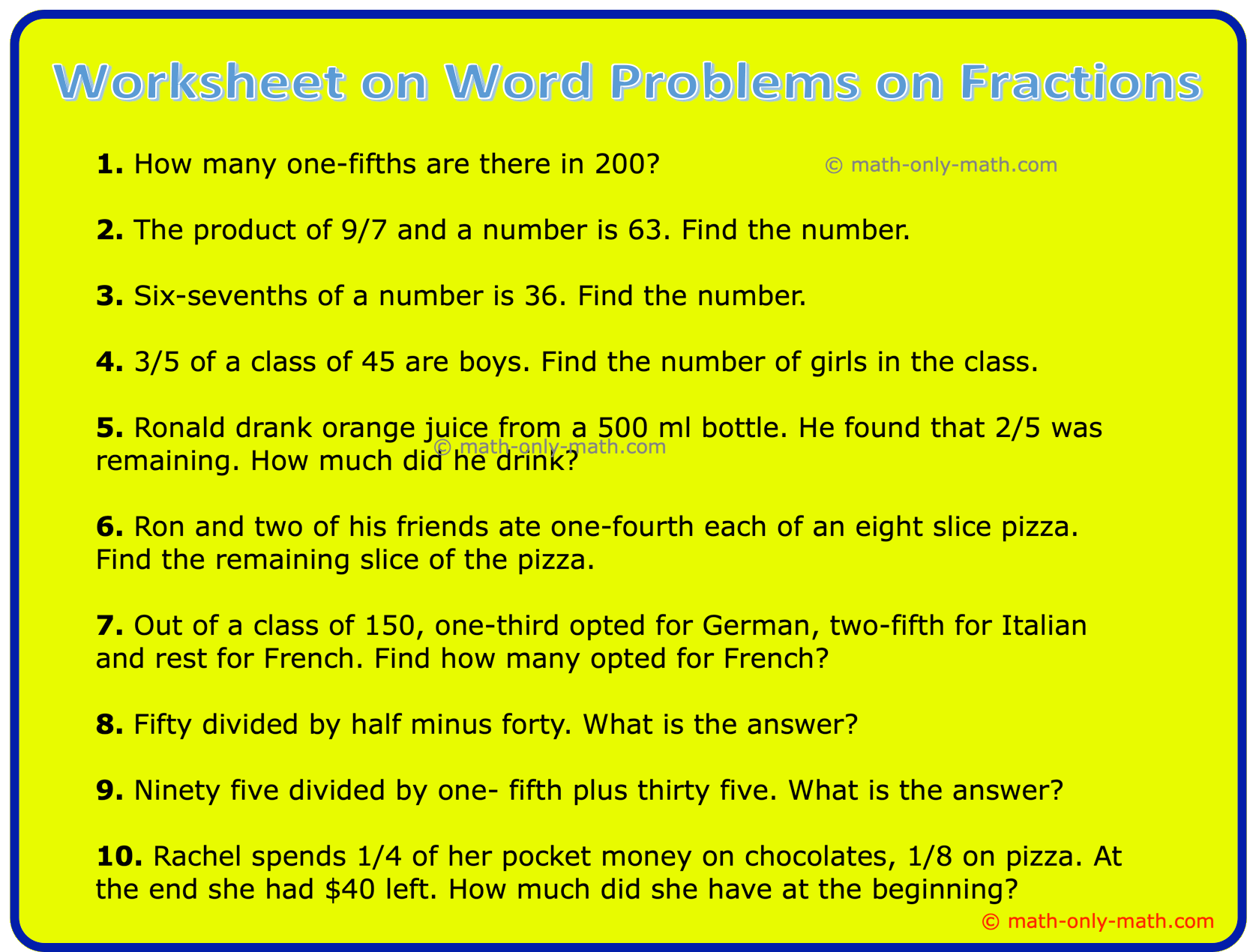Like and Unlike Fractions
Like and unlike fractions are the two groups of fractions:
(i) 1/5, 3/5, 2/5, 4/5, 6/5
(ii) 3/4, 5/6, 1/3, 4/7, 9/9
In group (i) the denominator of each fraction is 5, i.e., the denominators of the fractions are equal.
The fractions with the same denominators are called like fractions.
In group (ii) the denominator of each fraction is different, i.e., the denominators of all the fractions are different.
The fractions with different denominators are called unlike fractions.
Examples of like fractions are:
(a) (2/9, 3/9, 5/9, 9/9);
(b) (3/10, 7/10, 1/10, 9/10);
(c) (1/7, 2/7, 4/7, 5/7, 7/7)
Examples unlike fractions are:
(a) (1/2, 1/4, 2/3, 5/6)
(b) (3/8, 2/3, 3/5, 2/7)
(c) (1/9, 2/7, 3/4, 2/5).
Like Fractions:
Observe the following figures.
The fraction 18, 28, 38 have the same denominator. Such fractions are called like fractions.
Unlike Fractions:
In figure (i) one part is shaded out of 3 parts, the fraction represented is 13.
In figure (ii) has two parts shaded out of 3 parts, the fraction represented is 25.
In figure (iii) we have three parts shaded out of 7 parts, the fraction represented is 37.
The fraction 13, 25, 37 have different denominators. Such fractions are called unlike fractions.
Worksheet on Like and Unlike Fractions:
1. Which of the following is a set of like fractions?
|
(i) 19, 59, 49, 119 (iii) 411, 58, 79, 17 |
(ii) 17, 28, 419, 76 (iv) 411, 58, 79, 17 |
Answer:
1. (i) First set is like fractions because denominators are the same.
2. Which of the following is a set of unlike fractions?
|
(i) 113, 1315, 1517, 1719 (iii) 416, 116, 216, 916 |
(ii) 412, 512, 812, 912 (iv) 89, 17, 78, 811 |
Answer:
2. (i) First and fourth sets are unlike fractions because denominators are not the same
Related Concept
● Representation of a Fraction
● Properties of Equivalent Fractions
● Comparison of Like Fractions
● Comparison of Fractions having the same Numerator
● Conversion of Fractions into Fractions having Same Denominator
● Conversion of a Fraction into its Smallest and Simplest Form
● Addition of Fractions having the Same Denominator
● Subtraction of Fractions having the Same Denominator
● Addition and Subtraction of Fractions on the Fraction Number Line
4th Grade Math Activities
From Like and Unlike Fractions to HOME PAGE
Didn't find what you were looking for? Or want to know more information about Math Only Math. Use this Google Search to find what you need.
Recent Articles
-
Circle the Smallest Number | Encircle the Smallest Number | Small Numb
Apr 17, 25 04:22 PM
In math worksheet on circle the smallest number that comes accordingly so that kids can practice this sheet at home. In this sheet children need to analyze the smaller number and then identify -
Circle the Greatest Number | Encircle the Greatest Number | Identify
Apr 17, 25 04:08 PM
In math worksheet on circle the greatest number that comes accordingly so that kids can practice this sheet at home. In this sheet children need to analyze the greater number and then identify -
Bigger or Smaller Number | Larger or Smaller Numbers | Basic Math
Apr 17, 25 03:48 PM
We will learn how to identify the bigger number or smaller number. First we need to identify which object is bigger and which object is smaller and then we will learn to identify the bigger or smaller… -
Worksheets on Missing Numbers from 1 to 10 | Identify Missing Numbers
Apr 17, 25 03:28 PM
Printable worksheets on missing numbers from 1 to 10 help the kids to practice counting of the numbers. -
Subtraction of Decimals | Subtracting Decimals | Decimal Subtraction
Apr 17, 25 01:54 PM
We will discuss here about the subtraction of decimals. Decimals are subtracted in the same way as we subtract ordinary numbers. We arrange the digits in columns
















New! Comments
Have your say about what you just read! Leave me a comment in the box below. Ask a Question or Answer a Question.